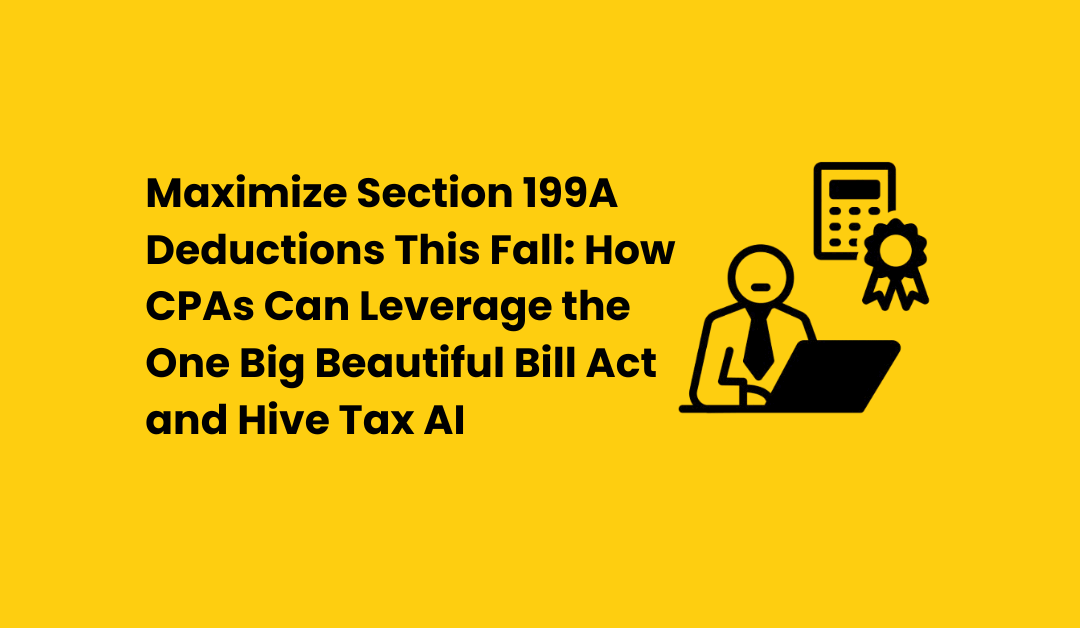As fall tax season heats up, CPAs must revisit Section 199A strategies—especially business aggregation and documentation basics—to maximize the 20% Qualified Business Income deduction. Thanks to the One Big Beautiful Bill Act, Section 199A is now permanent, offering newfound certainty for planning. Pair this with AI-powered tools like Hive Tax AI and Hive Tax Planning to streamline research and deliver sharper guidance. Dive in for actionable strategies and expert tech tips to stay ahead.
1. Section 199A: Now a Permanent Planning Anchor
The One Big Beautiful Bill Act, enacted July 4, 2025, permanently extends the 20% Qualified Business Income (QBI) deduction under Section 199A—originally set to expire at the end of 2025 . It also boosts the phase‑in ranges—raising them to $75,000 (single filers) and $150,000 (joint). Additionally, it introduces an inflation‑adjusted minimum QBI deduction of $400 for taxpayers with at least $1,000 of active QBI.
Why it matters: This permanence grants CPAs the predictability essential for long-term strategic client planning—no more scrambling for last-minute extensions.
2. Aggregation Strategies: Combine Wisely, Deduct More
Aggregation of multiple qualified trades or businesses can help meet thresholds or boost wage and capital limitations.
- Material participation matters: Only businesses in which the taxpayer materially participates and that generate active QBI qualify for the new minimum deduction.
- Consider aggregation of businesses (e.g., firms with overlapping management or services) to consolidate QBI, W‑2 wages, and underlying asset bases—potentially enhancing the 199A benefit.
- Document eligibility: Establish clear business structures, maintain reliable records of W‑2 wages and qualified property, and gather financials per aggregation requirements.
3. Documentation: Don’t Let It Be Your Weak Link
Proper record‑keeping is now more critical than ever. Ensure:
- Clear tracking of W‑2 wages and qualified property to support wage‑based limitations.
- Minutes or formal resolutions confirming aggregation elections.
- Evidence of material participation—logs or schedules showing time and level of participation in each business.
- Inflation adjustments: Keep track of thresholds as they adjust over time.
4. The One Big Beautiful Bill Act: More Than Just 199A
Beyond Section 199A, the Act brings sweeping tax certainty and new planning windows:
- Permanent enhancement of TCJA features—lower brackets, higher standard deduction, repeal of personal exemptions.
- Child Tax Credit raised to $2,200, indexed for inflation.
- SALT deduction cap increased to $40,000 for five years.
- New deductions: For tipped workers, overtime pay, and car loan interest on U.S.‑assembled vehicles, all through 2028.
- Expanded estate/gift tax exemption and clean energy provisions reshaped—some phased out or constrained.
CPA takeaway: These changes create impactful tax planning opportunities across individuals and pass-through clients. Align planning strategies early this fall to harvest benefits before temporary provisions begin phasing out.
5. Streamline Your Workflow with Hive Tax AI & Hive Tax Planning
To manage this fall’s complexity, integrate advanced AI tools into your practice:
- Hive Tax AI: Speeds up tax research, surfacing relevant tax law insights—like updated QBI rules or Act-specific provisions—in seconds instead of hours.
- Hive Tax Planning: Automates scenario modeling, letting you test the impact of aggregation, threshold changes, or client-specific deductions quickly and with confidence.
Best Practices:
- Input client data (e.g., incomes, business types, wages).
- Model outcomes under Section 199A aggregation versus stand-alone.
- Visualize impact of new deductions (e.g., tip, overtime, car interest).
- Keep audit-friendly documentation—exportable models and research summaries from Hive Tax.
6. Sample Action Checklist for Fall Season
| Task | Why It’s Essential |
| Review clients with pass-through businesses | Identify those maximally positioned for 199A benefits |
| Evaluate aggregation eligibility and benefits | Potentially higher deduction thresholds and QBI shares |
| Ensure W-2 wage and property tracking | Critical for limitations and verification |
| Run “what if” scenarios in Hive Tax Planning | Quantify savings from aggregation or new deductions |
| Document research rationale clearly (using Hive Tax AI outputs) | Improves defensibility and client trust |
| Monitor temporary deductions expiry beyond 2028 | Plan ahead, especially for clients relying on new provisions |
The One Big Beautiful Bill Act has solidified the 199A deduction and other planning tools—offering CPAs a golden fall-season opportunity to deliver strategic, predictably structured guidance.
Ready to transform your tax season toolkit? See how our AI tax tool AI tax research and AI tax planning tools can elevate your practice?

